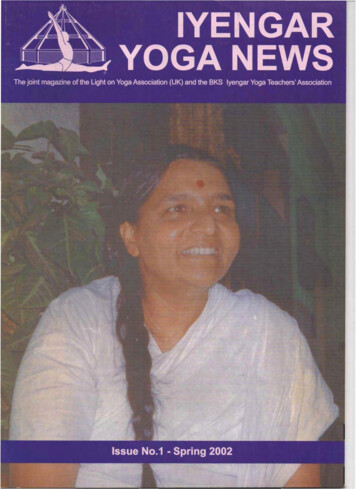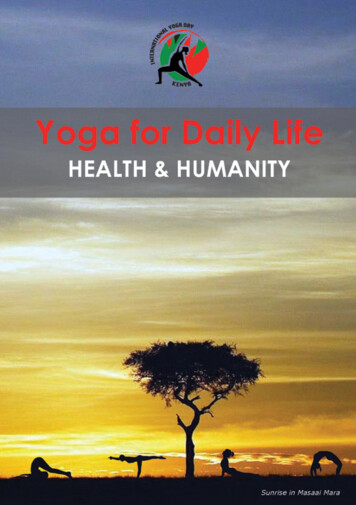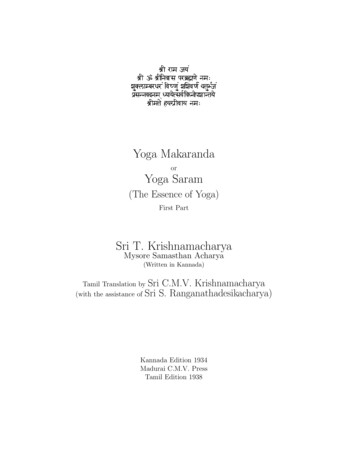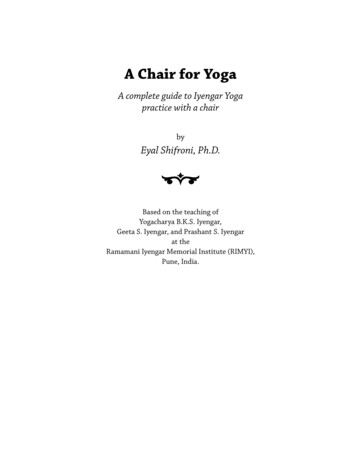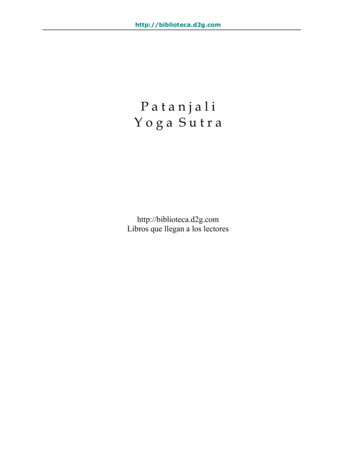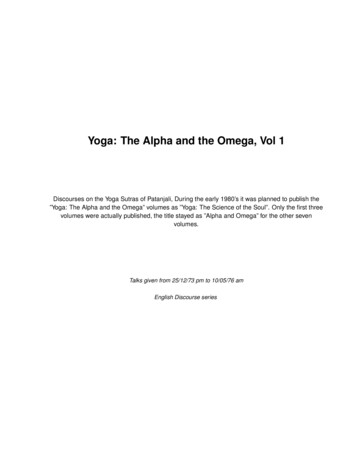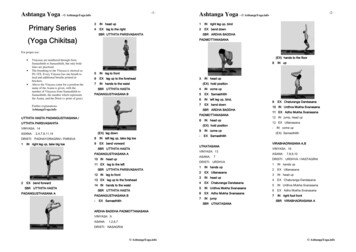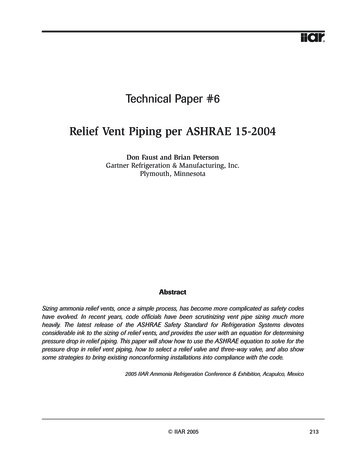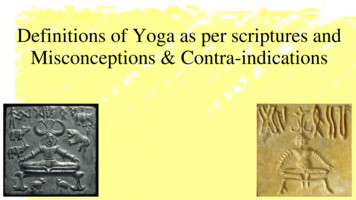
Transcription
Definitions of Yoga as per scriptures andMisconceptions & Contra-indications
Evolution of YogaPre-Classicalperiod Before 3000 BC: Depictions of Yoga postures in Harappa & Mohanjodaro3000 BC- 800 BC: Vedic period, yoga was done to develop concentration. Therituals were different with aim to attain union with God.800 BC- 250 BC: Upanishads, Ramayana, Mahabharata, Bhagwad Gita, YogVashishta contain many references. Yoga was more of lifestyleClassical periodPatanjali compiled and systematized the knowledge in 195 aphorisms and gaveAshtanga yoga for attaining samadhi. He didn’t mention any asana or pranayama.Post ClassicalperiodGheranda and Swatmarama introduced asanas, kriyas, pranayama for cleansingbody and mind, also introduced classical postures and bandha.Modern periodVivekananda, Yogananda, Ramanna Mahirshi influenced the western world toaccept yoga as a universal spiritual practice. Recently, BKS Iyengar, Shivananda,Swami Rama, Aurobindo, Osho have contributed to Yoga.
Why Yoga Science solved problems of all materialistic world with inventions butcouldn’t solve the root of psychosomatic disorders. They searchedoutside and made tremendous progress in the gross world.However, Ancient Sages/Rishis realized in their deep intution state thatthis false linking of the self with body-mind complex was the root of allsuffering. Our sages went inside into the subtle world. This state is to beself experienced as this state is beyond the cognition of the senses.Our Sages had unlocked the keys of permanent happiness by removingbondage and misery forever.Specific techniques were developed and were documented in scriptures.
Etymology of the word YogaThe word Yoga has been derived from Samskrita root/dhatu word Yuj. Ithas three meanings as per PaNini dhatupad.1)Yuj Samadhau- Yoga means achieving the state of samadhi (selfrealization). #Sat-Chit-Anand, Full of Consciousness. Advaiti.2)Yujir Yoge-Yoga is the uniona of the individual soul with the Universalsoul. #Layer of ignorance (Vritti/Sanskaras) like water pot in ocean.3)Yuj Sanyamane- Yoga is the censuring of the thought waves in themental pond so that we can see the self clearly. #Hatha v/s Raja Yogaa-This state can be called Viyoga as Yogi has disconnected himself with everything else andresting in his self which is free from superimposition of ignorance and all dualities.
Definitions of Yoga- An Overview of Scriptures1) Yum Prakrityo Viyogepi .(Samkhya Darshana)2) YogaH Chitta Vrutti NirodhaH. (PYS-1.2)3) ManaH Prashamana Upayaha YogaH iti Abhidhiyate. (Yog Vashishta3.9.32; Mahopanishad-5.40)4) Samsarottarane yuktiH yogasabdena kathyate. (Yog Vashishta-6.1.13.3)5) Samatvam YogaH Uchyate. (BG-2.48)6) YogaH Karmasu Kaushalam. (BG-2.50)7) Yuktahara viharasya. (BG-6.17)8) Tam Vidyaat Dukhasamyoga. (BG-6.23)9) Taam Yogamiti. (Kathopanishad-2.3.11)10) Ijya AcharaH DamaH Ahimsa Danam Swadhyaya Karmanam AyamParmo Dharma Yadyogena atmano Darshanam (Yajnavalkiya Smriti-1.8)
Samkhya Darshana (1)Sage Kapila defined yoga as belowYum Prakrityo viyogepi Yoga Ityabhidhiyate (Samkhya)Distinguishing clearly between purusha and prakriti, and establishing ofpurusha in his own pure state is yoga. #Sva Stha- Established in self#Matter (Moon) and Consciousness (Sun), Blind & Lame, (Rajju SarpaBhranti-Superimposition). #Ayurveda definition of health
Patanjali Yoga Sutras (3)Sage Patanjali describes the definition/goal in the very first chapter of hisepic Patanjali Yoga Sutras as belowYogaH Chitta Vrutti NirodhaH (PYS-1.2)Yog is the cessation and removal of fluctuations in the mind which areresponsible for rebirth and suffering.#Avidya the root - Sara Aadhi, Samanya Aadhi in Manomaya Kosha, Vyadi inAnnamaya kosha, Sympathetic overdrive-Car without breaks. #Ashtanga Yog
Yog Vashista (2)Samsarottarane yuktiH yogasabdena kathyate Tam viddhi dviprakaram tvam chittopasam (Yog Vashista-6.1.13.3)They call it yoga which is the method by which this cycle of birth and death ceases. Itis utter transcendence of the mind and of two types. Self-knowledge (Jnana) is onetype, restraint of the life-force (Yoga-Pranayama) is another. However, yoga hascome to mean the latter. Yet, both methods lead to the same result. To some, selfknowledge through inquiry is difficult; to others, yoga is difficult. But selfknowledge is easily achievable as for pranayama you need have correctcombination of desha, kala, asana. But Sadhaka should not think like this as bothmethods as approved by shastras.
Yog Vashista-Mahopanishad (3)Manah prashamana upayah Yoga Iti Abhidhiyate (Yog Vashishta 3.9.32; Mahopanishad 5.40)Yog is the technique to Pacificy the mind.#Mana Eva Manushyanam Bandhnam Karana MokshyayoH (BG-6.5)Mind is the cause of liberation or confinement. #Manasa-Vacha-Karmana
Bhagwad Gita (2)Krishna says to Arjuna in Bhagwad GitaYogastha Kuru Karmani sangam tyaktva dhananjaya Siddhyasiddhyo samo bhutva samatvam yoga uchyate (BG-2.48)O Arjuna, You remain fixed in Yoga and then do all the actions, abandonattachment, be equal in success and failures, as Yoga means equanimity.#Eligibility for action (Karma) only not on results (Phala), KarmaAkarma- Akarma-Karma
Bhagwad Gita (3)Krishna says to Arjuna in Bhagwad GitaBuddhiyukto jahatiha ubhe sukritadushkrite Tasmaatyogaaya yujyasva yogaH karmasu kaushalam (BG-2.50)A wise man refrains from performing both good and bad actions in thisworld. Thus, engage in yoga, as yoga is the best of all activities.#Harmony between head, heart and hands- Sivananda
Bhagwad Gita (3)Krishna says to Arjuna in Bhagwad GitaYuktaahara viharasya yuktacheShTasya karmasu Yuktasvapnaava bodhasya yogo bhavati dukhahaa (BG-6.17)For one who is moderate in eating and recreation, temperate in actions,regulated in sleep and wakefulness, yoga becomes the destroyer of pain.#Moderation awareness introspection YOGA#Atma Manasa Samyujyate Manaha IndriyenaIndriyam Arthena, #Pratyahara, #Pratipaksha Bhavanam
Bhagwad Gita (2)Krishna says to Arjuna in Bhagwad GitaTam Vidyaat Dukhasamyogaviyogam yogasangyitam Sa Nishchayena yoktavyo yogonirviNNachetasa (BG-6.23)Let this disconnection from union with pain be known by the name ofyoga. This yoga should be practised with determination and with anundistracted mind.#Steadfastness, #Consistency, #Systematic, #Boiling milk
Bhagwat Gita (3)Shrutivipratipanna te yada sthaasyati nishchalaa Samaadhaavachalaa buddhistadaa yoagamavaapsyasi (Gita-2.53)When your mind will remain stable even after hearing confusing andconflicting statements,then you will attain the state of Yoga- samadhi.#Yoga is a state of great steadiness at emotional level,balance of concentrationand detachment at mental level and homeostasis at body level.
Yajnavalkiya Smriti (2)Ijya AcharaH DamaH Ahimsa Danam Swadhyaya Karmanam AyamParmo Dharma Yadyogena atmano Darshanam (Yajnavalkiya Smriti1.8)Sacrifice, Ceremonial, self-control, Non-violence, donation, study of thevedas, and other acts than sacrifice have been separately mentioned.Among these perception of the real self by yoga is the highest dharma.#Trigunas, Both beastly and divine tendencies are present in a human. Bycontemplating on self, beastly tendencies are removed and Individualbecomes divine.
Kathopanishad (3)Taam Yogamiti manyante sthiramindriyadharanam Apramatastadaa bhavati yogo hi prabhavaapyayo (Kathopanishad-2.3.11)Stable and balanced state of body, mind and intellect is yoga. Withfirm control of senses, mind fixed in atman through meditation, theyogi is careful and vigilant. Here the Yoga is either acquired or lost.When the five senses stabilize with mind, intellect and get detachedfrom various subjects then the person achieves Paramagati.#Ratha Kalpana- Jeeva as Passenger, Driver is intelligence, Mind asreins, Senses as horses, Ratha as body,
Misconceptions of YogaBhrantya Bahumat Adhvante Rajayogam Ajanatam (HYP-1.3)Lot of misconceptions about Raja yoga as per Svatmarama1. Yoga is only for Hindus. 2. Yoga is only asana and it is for body only. 3. Purpose of yoga is therapy only. 4. To do yoga we must be flexible. 5. Yoga is only for the young. 6. Yoga is dangerous or too easy. 7. To do yoga, you must be vegetarian. 8. Yoga is only for people who renounce world. 9. Yoga can be taught by anybody.
Contraindications of Yoga 1Hatha Vidya param gopya yogina siddhimichataam Bhavetviryavati gupta nirviryaa tu prakashitaa (HYP-1.11)Hatha yoga is the greatest secret of the yogis who wish to attainperfection (Siddhi). To be fruitful, it must be kept a secret, if revealed itbecomes powerless.
Contraindications of Yoga 2AtyahaaraH prayasasch prajalpo niyamgrahaH Janasangasch laulyaM cha Shadbhiryogo vinaShyati (HYP-1.15)Overeating, overexertion, excessive talking, too much rigid adherenceto rules, being in the company of common people and wavering mindare six obstacles which destroy the progress in yoga.
Contraindications of Yoga 3Pranayamena yuktena sarvarogakshyo bhavet Ayuktabhyasayogena sarvarogasamudbhavaH By proper practice of pranayama, all diseases are eradicated. However,through improper practice all diseases can arise.#Unsystematic irregular Incorrect, Not following rules or sequence,without teacher. E.g practicing on full stomach.
Contraindications of Yoga 41)Over straining during yoga instead of as per the capacity. 2)Performing yoga without meal gap of at-least 3 hours. 3)Performing difficult practices during mensuration & pregnancy (especiallywhich impact abdomen). 4)Doing yoga without awareness. 5)Comparing your progress with others. 6)Regretting as unable to do any practice due to condition. 7)Doing yoga during fever. 8)Eating diet which doesn’t overheat the body. 9)Not following Yama (Social discipline) and Niyama (Individual rules) 10)Not modifying the postures as per the ability.
Adverse Events Associated with Yoga: A Systematic Review ofPublished Case Reports and Case Series (Cramer, Krucoff, Dobos, 2013)76 cases were taken. Ten cases had medicalpreconditions, mainly glaucoma and osteopenia.Mostly below were practiced.1) Pranayama (forceful breathing)2) Hatha yoga and Bikram yoga (headstand,shoulder stand, lotus position) Yoga should be practiced carefully under theguidance of a qualified instructor. Beginners should avoid extreme practices such asheadstand, lotus position and forceful breathing.Individuals with medical preconditions shouldwork with their physician and yoga teacher toappropriately adapt postures; Patients with glaucoma should avoid inversions Patients with compromised bone should avoidforceful yoga practices.DescriptionNo.%Musculoskeletal system2735%Nervous system1418.4%Eyes911.8%Full recovery1519.7%Partial recovery911.35No recovery11.3%Died11.3%Total76100%
Yoga-Related Injuries in the United States From 2001 to 2014(Swain & Mcgwain,2016)A 13-year descriptive study was conductedfrom 2001 to 2014 were used to estimatethe incidence and type of yoga-associatedinjuries. There were 29,590 yoga-relatedinjuries seen in hospital emergencydepartments from 2001 to 2014.
Injury in yoga asana practice: Assessment of the risks (Wiese et.al,2018)2620 participants completed a survey using convenient sampling (79% were between ages 31and 60 and 84% were female)1) 45% of participants reported experiencing no injuries during the time they had beenpracticing yoga.2) 28% experienced mild injury in asana practice (e.g., sprains or non-specific pains notrequiring a medical procedure, with symptoms lasting less than 6 months).3) 63% were moderate (e.g., sprains or non-specific pains not requiring a medical procedure,with symptoms lasting from 6 months to 1 year).4) Only 9% of those reporting injuries (4% of the total sample) had a severe injury.Greater number of years of practice (p .0001) and teaching yoga (p .0177) wereassociated with increased risk of injury.Number of injuries reported by yoga participants per years of practice exposure to be low and
References1) Bhagwad Gita2) Samkhya Karika3) Hatha Yoga Pradeepika4) Yog Vashishta5) Kathopanishad6) Yajnavalkiya7) Mahopanishad8) Patanjali Yog Sutras
References
Tasmaatyogaaya yujyasva yogaH karmasu kaushalam (BG-2.50) A wise man refrains from performing both good and bad actions in this world. Thus, engage in yoga, as yoga is the best of all activities. #Harmony between head, heart and hands- Sivananda . Bhagwad Gita (3) Krishna says to Arjuna in Bhagwad Gita Yuktaahara viharasya yuktacheShTasya karmasu Yuktasvapnaava bodhasya yogo
